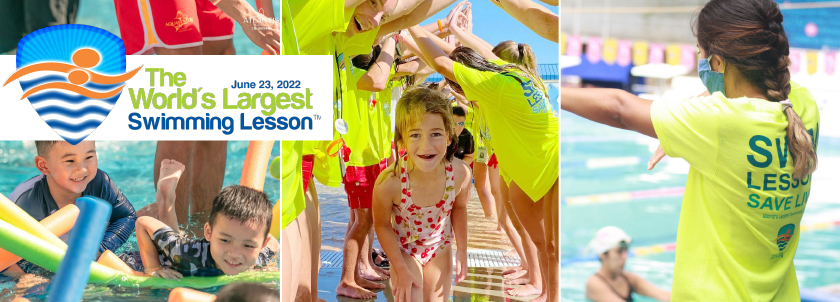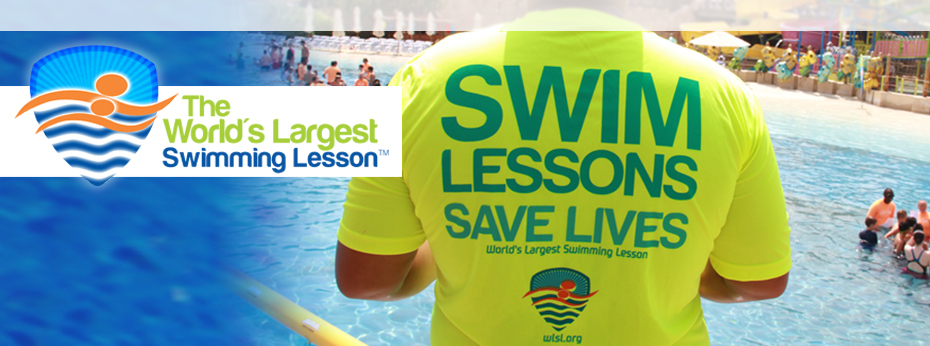The World’s Largest Swimming Lesson is an annual event that will take place on June 23, 2022, across the globe. We sat down with Juliene Hefter, Executive Director and CEO of AOAP, the Association of Aquatic Professionals, to talk about their involvement in the global cause of preventing drowning.

Q: We know that AOAP is a Supporting Organization of WLSL. How did that partnership start, and why did you think it was essential to be involved?
A: One of AOAP’s main initiatives is drowning prevention and education. The World’s Largest Swimming Lesson is a perfect example of that.
Q: How do you feel WLSL benefits communities?
A: Everyone should learn how to swim at any age. This program highlights the importance of learning to swim and gives communities the opportunity to at least introduce everyone within the community to swim lessons and what they entail. It is hoped that by inviting anyone and everyone within the community to join in during the #WLSL2022, they will be able to introduce new people within their communities to what swim lessons can do for them. Teaching everyone this lifelong and lifesaving activity is one the most important things that we can do for our communities as aquatic professionals.
Q: Aquatics professionals are spread pretty thin right now. Do you have any tips or resources to help someone new to the program get started?
A: Education and Networking! Continuing education and networking are the two items that are a MUST for new aquatic professionals or seasoned professionals. By continuing to attend workshops, conferences, seminars, webinars, etc aquatic professionals can ensure that they are meeting the needs of the community by offering, not only the staples in programming and special events, but, also keeping up-to-date on new and innovative technology, equipment and programs as well as legal liability and staffing issues. Being involved in a membership association, such as the Association of Aquatic Professionals, provides a much-needed network of aquatic professionals and resources to help ensure that you are staying up to date on everything and have access to other members for assistance whenever you need it. Things such as the new Connect with AOAP’s Newest Member Benefit: Connect with other AOAP members, contribute to the resource library, ask questions and get answers, and more with our new member portal. Visit AOAP Connect Here. Also, keeping up to date with aquatics happenings throughout the year by signing up for weekly e-newsletters such as the AOAP Weekly that goes out to over 27,400+ individuals each Wednesday: AOAP Weekly Signup
Q: What have you seen other communities do to make the program fun for the participants?
A: There are so many new and exciting things that aquatic facilities can do to bring people in—looking at all of the latest and exciting trends in aquatics that are out there. From log rolling to sup yoga, aqua bikes, kickboxing, Ninja Cross over pool courses, liquid gym, stars and loops, SAF Aqua Drums, HydroRevolution, Sup boards, climbing walls, blow up obstacle courses, to name a few, and creative special events and programs. I think the more innovative aquatic facilities can be, the better, especially with trying to build back up our aquatic communities. Typically, communities that introduce new and exciting items experience a great return on their investments.
Q: That’s a lot of little swimmers together – do you have any suggestions for the instructors involved?
A: Layers of protection are a MUST to have in place. Class sizes need to be manageable, and as an instructor, you need to make sure that you are always working within an arm's reach of your young swimmers. Having them sit on the wall when you are not working with them and moving along the wall so that you are not moving far away from them is important. That way, you can keep an eye on everyone while working with individuals. Safety measures must be put in place. Instructor-to-student ratios should be set up based on the age and abilities of the students. Additionally, lifeguards must be present anytime your community facility is open to the public for community open swim, swim lessons, swim teams, PE classes, lifeguard and swim instructor training, water exercise classes, lap swimming, etc. Lifeguards need to have no other duties assigned to them that will take away their constant, direct, uninterrupted supervision of the individuals in the water.
Q: AOAP Partners with a lot of organizations. What is the main reason for that?
A: One of the main goals of AOAP is to collaborate and partner with any and all aquatic organizations to ensure that we are meeting the needs of the aquatics industry. AOAP wants to be a one-stop-shop for all aquatic professionals and companies. Through those partnerships and collaborations, we can better meet the needs of aquatic professionals nationally and internationally. We currently have partnerships for our Annual Conference and Exposition that include, but, are not limited to Counsilman-Hunsaker, Diversity in Aquatics (DIA), Council Model Aquatic Health Code (CMAHC), NIRSA: Leaders in Collegiate Recreation, Starfish Aquatics Institute (SAI), Total Aquatic Programming (TAP) and our newest collaboration with the National Drowning Prevention Alliance (NDPA) who will be offering their annual convention in conjunction with AOAP’s Conference and Exposition beginning in 2023. If anyone is interested in partnering with AOAP and offering any type of education or holding any meetings or training in conjunction with the AOAP Conference, please contact Juliene Hefter, the Executive Director/CEO, at [email protected] or 262-894-9772
Q: Do you have any resources you’d like to share?
A: I shared some above but would also like to mention our Aquatic Professionals Designation. One of the Association of Aquatic Professionals’ main goals is to assist in recognizing individuals in the aquatic field as professionals. Our first step was the development of the aquatic professional's designation. Become recognized in the Aquatic Profession as a Designated Aquatic Professional (AqP). Stand out among your peers and obtain this designation through education, experience, and certifications.
Do you want to be recognized as an Aquatic Professional within the aquatic industry? Then this designation is for you. Through a combination of education, experience, and training, you may be recognized as an AqP. https://www.splash-edu.org/courses/aquatic-professional-designation-aqp
Q: Any closing thoughts?
A: As Aquatic Professionals and Organizations, we must continue to strive to be the best that we can all be. By continuing to grow as professionals every day and never stop learning, we, along with our partners and colleagues, can prevent drownings and teach our community members the importance of layers of protection in and around the water! Stay safe and keep splashing!

Helpful Links:
The World’s Largest Swimming Lessons Website
Counsilman Hunsaker and HydroApps proudly partner with the Association of Aquatic Professionals to support aquatic professionals in making a positive impact on their community. Together with AOAP, we promote enhanced risk management, water safety, and drowning prevention to serve and enrich the aquatic experience.
Juliene Hefter – has a passion for aquatics! Her long and illustrious career started in aquatics and park and recreation administration and has grown to serve as the Executive Director and CEO of one of the largest aquatic organizations in the world. She has held a number of leadership positions with state and national organizations, is a renowned speaker and author on a variety of management and administrative topics, and has been recognized by Aquatics International as one of the top 10 Aquatic Advocates, Power 25, and received the International Swimming Hall of Fame’s Paragon award. Juliene has sat on the Sounding Board to develop the American Red Cross 2012 Lifeguarding Program and assisted in the development of the Lifeguard Management curriculum. She also contributed to the development of the Starfish Aquatics Technician Program and is one of the founders of the Association of Aquatic Professionals.
AOAP – The Association of Aquatic Professionals promotes policies, practices, and procedures that contribute to safer and improved aquatic education, aquatic recreation activities, programs, and facilities. They provide and support quality aquatic education opportunities and aim to coordinate and conduct research in the field of aquatic management and safety. AOAP hosts an annual conference and educational workshops for communities on drowning prevention and education. A portion of all proceeds are used towards drowning prevention through Learn to Swim Program Lessons and Grants for Life Jackets. To learn more about their Life Jacket Grant Program, click here.
